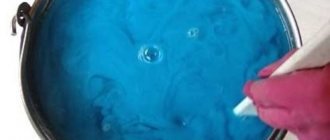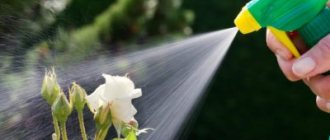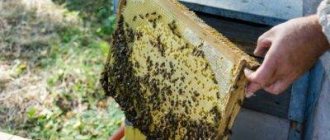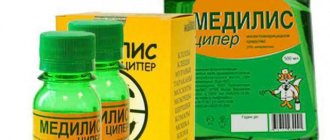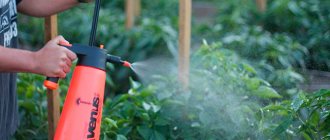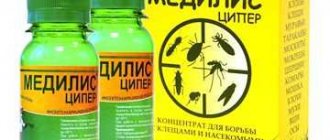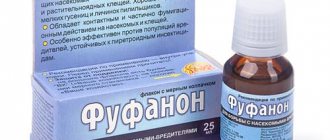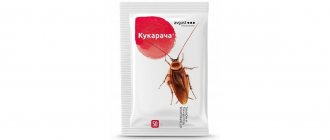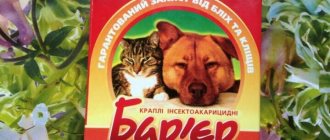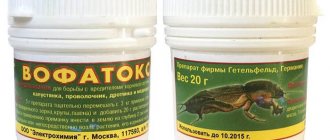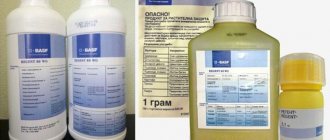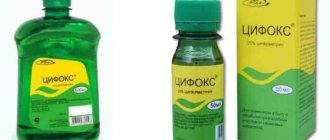Many summer residents have heard of such a drug as Bordeaux mixture. The use of fungicides in horticulture began with her. We tell you what Bordeaux mixture is, how to prepare it and use it correctly in the garden.
Known to many summer residents, Bordeaux mixture is the first fungicide in the world, which is still actively used to protect fruit and berry crops from fungal diseases. The mixture was invented in the 2nd half of the 19th century. French botanist P. Milliard, who lived in Bordeaux.
One of the first labels of Bordeaux liquid and a portrait of its inventor - Pierre Marie Millardet (1838-1902)
Nowadays, Bordeaux mixture is used to combat common plant diseases, such as:
- rust, scab, fruit rot, powdery mildew (in fruit and berry crops);
- macrosporiosis, late blight (in tomatoes, potatoes);
- septoria, downy mildew, anthracnose (in cucumbers);
- mildew (in grapes);
- spotting (in raspberries, strawberries), etc.
What is Bordeaux mixture and what is it used for?
Description of the drug
Bordeaux mixture or mixture is a preparation that consists of copper sulfate and lime. It is sold in the form of a powder or concentrate, which just needs to be diluted with water. It can also be made at home by mixing copper sulfate and slaked or quicklime yourself.
The ready-to-use solution looks like an opaque liquid of a pale blue color. It adheres well to the surface of plants and lasts up to 30 days.
Bordeaux mixture is used to protect garden crops from various diseases, mainly fungal ones. On fruit trees and shrubs it helps against scab, rust, powdery mildew, anthracnose, blight, rubella, coccomycosis, clusterosporia, fruit rot and other diseases. On vegetable crops, it fights pathogens of late blight, peronospora, cercospora, rust, septoria, bacteriosis and various rots. It protects grapes from rubella, melanosis and mildew. It is also used to treat medicinal and ornamental plants. However, it must be used in advance, as a preventive measure, at the latest when the initial signs of disease appear.
Bordeaux mixture repels some insects, but in general it does not help against agricultural pests. Due to the fact that the Bordeaux mixture contains lime, the drug acts more gently and is less dangerous for plants than pure copper or iron sulfate.
Chemical composition and price
Active ingredients of the drug:
- copper sulfate;
- lime;
- water.
Copper is the main active ingredient; it is this chemical element that gives the solution a beautiful blue color. It effectively fights many pathogenic bacteria and fungi, but excess can cause harm to crop plants. Copper can cause burns on foliage and other parts of plants, so lime is added to Bordeaux mixture as a neutralizer.
Although Bordeaux mixture is inexpensive, gardeners can still save money if they prepare it themselves at home.
However, it should be borne in mind that when Bordeaux mixture is produced in a factory, the dosage of all components is carefully observed, which is not always possible at home.
Operating principle
The principle of the effective action of the drug is that under the influence of carbon dioxide hydrolysis occurs in plants, so the salt of copper sulfate actively decomposes.
As a result of such a reaction, a thick sediment is formed that adheres to leaf surfaces, completely covers them and prevents pathogenic infections from penetrating inside.
Important! Treatment with Bordeaux mixture is not carried out if it is a hot, rainy summer - in such conditions, hydrolysis occurs more actively, as a result of which the drug decomposes faster. And the effect of using the product will be short.
Advantages and disadvantages
The main advantages of Bordeaux mixture include:
- after treatment, the effect on pathogenic microorganisms quickly begins; not washed away by precipitation;
- protective effect for plants after spraying – at least 30 days;
- can be used against many pathogenic bacteria and fungi;
- can be used to process many garden and vegetable crops;
- low price of the drug.
But Bordeaux mixture also has its disadvantages , which you need to remember:
- the drug cannot be used in tank mixtures with organophosphate pesticides and those substances that decompose in an alkaline environment;
- processing is carried out carefully, processing leaf plates and stems from all sides;
- copper is harmful to the human body, so when working with the drug you must follow safety rules;
- increasing the dosage or number of treatments can harm the plants, since Bordeaux mixture is phytotoxic;
- the components of the drug gradually accumulate in the soil, so Bordeaux mixture should not be used often;
- when increasing the dosage when preparing the working solution, it can burn the leaf plates;
- The product is used immediately after preparation, since when stored in a solvent, its components can clog the sprayer holes.
But if you use the drug in accordance with the instructions, there will be no such disadvantages.
History of creation
Even in ancient times, people noticed that copper sulfate kills fungi of all types. It is not for nothing that copper sulfate is sold as a separate product in our time. It is used by builders and carpenters to treat wood against rotting. Wood impregnated with this substance is practically not subject to rotting and mold in damp places: basements, cellars, attics, bathhouses.
Treating logs and boards with Bordeaux mixture is not difficult, since the wood absorbs the copper compound well. The situation is more complicated with living plants that cannot retain copper sulfate on their leaves. For this, lime was added, that is, milk of lime. Slaked lime, together with copper sulfate, forms a new compound called Bordeaux mixture.
The developer of this mixture was the French botanist Pierre Marie Millardet. Initially, the find was used to protect and treat vineyards from the mold fungus Plasmopara viticola, which provokes the development of a disease such as downy mildew.
Nowadays, Bordeaux mixture is used in a wide range. In addition to vineyards, other plants are also treated with it against fungal diseases:
- Tomato and potato bushes from macrosporiosis, late blight;
- Vegetables such as cucumbers, onions, garlic, carrots from septoria, downy mildew, anthracnose;
- Berry crops such as raspberries, strawberries, strawberries from spotting;
- Fruit bushes and trees from rust, scab, fruit rot, powdery mildew;
- mildew (grape).
How to prepare Bordeaux mixture at home
All components are mixed according to certain rules. You can’t just pour them into a common container and add water. It is necessary to dilute copper sulfate and lime separately, and then combine them.
It is more convenient to prepare the drug for 10 liters at once. To do this, you will need two 5-liter buckets, one 10-liter bucket, a wooden stirrer and gauze or a fine-mesh sieve for filtering. All containers must be either plastic (preferably polypropylene or PVC) or glass. You can use enamel cookware without chips or scratches on the coating, but in no case metal.
In what proportion to mix copper sulfate and lime depends on how strong the solution is needed - 1% or 3%. To obtain 3% Bordeaux mixture per 10 liters of water, you will need 300 g of copper sulfate powder and 300-400 g of quicklime (slaked lime - 50 g less). For a 1% solution, take 100 g of vitriol and 100-140 g of quicklime (slaked - 100 g). The optimal ratio is 1:1 or 3:4, i.e. lime a little more.
What is the sequence of actions:
1. First make a solution of copper sulfate . To prepare it, use hot water at a temperature of 45-50°. Pour 2 liters of water into a 5-liter bucket and, stirring constantly, gradually pour vitriol into it. When it is completely dissolved, another 3 liters of heated water is poured into it, stirring again.
2. Then lime milk is prepared . First, the lime is slaked. To do this, pour it into another 5-liter bucket and, stirring, pour cold water into it in a thin stream until a creamy mass is obtained. The process of slaking lime occurs rapidly - it hisses and splashes, so during this work you need to use personal protective equipment. When the reaction is over, add more water (a total of 5 liters is needed to dilute the lime). After this, the solution is continuously stirred for another 15 minutes. The result is lime milk, which is essentially diluted slaked lime.
3. Prepared solutions of copper sulfate and lime are mixed with each other in a 10-liter bucket. But first you need to let them cool, ideally to a temperature of about 15°. A solution of copper sulfate is poured into the milk of lime, gradually and stirring. This is a very important point. If you do the opposite, i.e. If you pour milk into vitriol, the resulting Bordeaux mixture will be less stable and effective.
4. Check the acidity of the resulting solution . It should be neutral, since it is too acidic to burn the leaves, and a highly alkaline one does not adhere well to the surface. To determine acidity, you can use special indicator strips or an ordinary clean nail. It is dipped into Bordeaux mixture, and if after 1-2 minutes a reddish coating appears on it, it means that the preparation is too acidic. A pre-prepared concentrated solution of slaked lime (100 g per 900 ml of water) must be added to it. However, do not overdo it - too much of it can also cause burns.
High acidity may be indicated by a greenish tint to the liquid, while a proper Bordeaux mixture should be sky blue.
5. The resulting solution is filtered through 4 layers of gauze or a sieve. Now it can be used.
You cannot add water to the finished Bordeaux mixture, otherwise it will quickly separate. It is also not recommended to mix it with other pesticides, especially organophosphorus ones. You should not add laundry soap to it either, this will not improve the adhesion of the drug. Bordeaux mixture is used immediately after preparation. If you store it for a long time, it loses its effectiveness and does not adhere well to plants. As a last resort, you can postpone its use for a day, and then to improve adhesion you can add sugar to it - 1 tbsp. spoon per 10 liters of solution.
What mistakes prevent you from getting a Bordeaux mixture?
Chemical equilibrium in suspensions is achieved only when all reaction conditions are met. The active ingredient of the fungicide is a mobile copper ion. Spraying will be useless if the salt has precipitated.
The copper sulfate solution itself has a pH of 4.2, the acidic environment is phototoxic and corrodes the leaves. To deliver Cu++ to plants and fix them on the leaf, an alkaline solution of lime is used. That is why it is necessary to pour the blue solution into the white one little by little so that it has time to dissolve. In this case, copper enters into an exchange reaction with Ca(OH)2 and soluble Cu(OH)2 is obtained. The equilibrium is mobile, the mixture contains SO4-, Cu++, OH-, Ca++ ions, the general chemical formula of the Bordeaux mixture is CuSO4*3Ca(OH)2.
The suspension is characterized by low concentration and is located on the boundary of the phase transition in a slightly alkaline environment. Moving from one form to another, they form a finely dispersed mixture with a size of 3-4 microns, and the alkaline environment creates guaranteed adhesion.
But if we change the conditions for connecting the two liquids, we get different results:
- We quickly add the blue solution to the white one - we get large green crystals of basic copper sulfate 3Cu(OH)2-CuSO4, insoluble in water. Crystals do not linger on the leaves when sprayed.
- Pour the white solution into the blue one - large particles are obtained, the solution quickly separates, and adhesion is low.
- Mixing hot or concentrated solutions will also produce large crystals and separation.
- If during the preparation of the mixture the pH of the solution is shifted to the acidic side, it is necessary to add lime milk, in approximately half the amount of the initial doses. This means that the activity of lime is weak and does not provide the required alkaline environment.
We believe that the manufacturers of the mixtures deliberately put a bag of lime in excess of the calculated weight. This ensures that the right environment is created. When purchasing reagents separately, it is worth considering the possibility of additional addition of lime milk and prepare it with a reserve.
Photo: bulat-tambov.ru/
Preparation of working solution
Preparing Bordeaux mixture is not difficult, but the process requires following the instructions for use. Depending on when treatment with this drug is carried out, a solution of different concentrations is prepared. To prepare a 1% solution you will need 100 g of vitriol and 120 g of lime, and to prepare a 3% solution - 300 and 400 g, respectively. The preparations are first diluted in different containers in a small amount of hot water, then brought to the required volume with cold water and the components are mixed.
After preparation, litmus paper is placed in the solution - if its color does not change or becomes red-crimson, then the solution is neutral or alkaline. If litmus turns blue, then Bordeaux mixture is alkaline and can be used for processing.
Soil disinfection
Soil disinfection is carried out in early spring and autumn before the onset of frost.
During the autumn period, November is the best time. The vegetative stage of plants is coming to an end and therefore the liquid will not harm them. Bordeaux mixture will destroy diseases that have accumulated over the entire season. Another advantage of autumn treatment is the extermination of garden pests without causing damage to beneficial insects.
Spring treatment is aimed at destroying fungal spores and pathogens. During kidney swelling, use a 3% solution. For further treatments, a 1% solution is suitable.
Instructions for use
Bordeaux mixture with a concentration of 3% is used to treat cultivated plants before the start of sap flow in early spring or after leaf fall in the fall. Spring treatment is more effective than autumn treatment, since during the period before bud break, fungal spores are very active and especially vulnerable. In the fall, they prepare for winter and are less susceptible to the effects of the drug. During the season, only a 1% solution is used to spray various crops.
Trees and shrubs are sprayed in the spring before buds begin to open or in late autumn after leaf fall with 3% Bordeaux mixture, and after the appearance of leaves, incl. in summer – 1%. Vegetables and other annual crops are treated exclusively with a 1% solution. During flowering, spraying is temporarily stopped so as not to poison bees and other pollinators.
Before starting treatment, you need to carry out some procedures in the garden. If work is carried out in early spring, it is necessary to monitor the weather - spraying cannot be carried out during rains. Also, when processing trees and shrubs in spring or autumn, you need to carefully inspect the tree trunk circles and remove all remnants of vegetation and fallen leaves from them. If the collected plant debris is not damaged by disease, it can be placed in a compost pit. Otherwise, it is burned outside the site or buried deep in the ground.
Spraying should be carried out in dry, windless weather early in the morning, so that the vegetative mass has time to dry during the day after spraying. It is advisable that after treatment there is no rain for several days - this way the drug will have time to act on pathogens and will not cause burns.
Important! If the weather is cold and rainy in autumn, it is better to leave the plants without such spraying, because it will be ineffective.
During autumn processing, you need to carefully water not only the garden crop itself, but also the tree trunk, without touching the lawn grass.
For spraying to bring maximum benefit, the liquid should remain on the plants in the form of a thin film, and not large drops, so it is better to use a fine sprayer. The entire surface must be covered with the solution so that pathogenic organisms do not have a chance to survive after treatment.
You cannot combine spraying plants with Bordeaux mixture with treating them with other preparations, as they can neutralize each other.
How to apply for different crops
Spraying with Bordeaux mixture is carried out carefully; you must try to treat all hard-to-reach places. When used correctly, the crops will be protected from pathogenic microorganisms for 30 days.
consumption rates for adult apple and pear trees are 10-15 l, for pome crops (plums, cherries) - 6-10 l, for any young trees - 2-3 l. When processing grapes, fruit and ornamental shrubs, 1.5 liters per 10 square meters are consumed. m. Tomatoes, peppers, eggplants, and cucumbers are sprayed at the rate of 2 liters per 10 square meters. m, and potatoes, beets and melons - 1 liter for the same area. For strawberries and wild strawberries, 0.5-1 liter per 10 square meters is enough. m.
For processing stone fruit crops
In early spring, before sap flow begins, the following fruit trees are treated with a 3% solution of this drug:
- plum;
- cherry;
- cherries;
- peaches;
- apricots.
During the growing season, two more treatments can be carried out with Bordeaux mixture (at a concentration of 1%). The interval between spraying should be 12-14 days. There is also 1 more treatment scheme - before buds open, after flowering, then at intervals of 2 weeks.
For young trees, 2 liters of working fluid is sufficient, and for adults – up to 10 liters.
For grapes
This garden crop can be treated with Bordeaux mixture only in early spring, using a 3% working solution. It is important to use for processing only the amount of working solution specified in the instructions for use, since excess copper leads to a deterioration in the quality of the harvested grape bunches and prevents new shoots from appearing.
For tomatoes
This vegetable crop is treated with a 1% solution of Bordeaux mixture against late blight and macrosporiosis. Tomatoes can be treated with this drug 4 times per season with an interval of 12-14 days. For every 10 square meters of area, up to 2 liters of working fluid are required.
For cucumbers
Cucumbers are treated with this drug against anthracnose, spotting and bacteriosis. This crop is sprayed up to 3 times per season with an interval of two weeks. For 10 sq. m area requires up to 2 liters of product.
For potatoes
Potatoes are treated with Bordeaux mixture (1% solution) against late blight and macrosporiosis. The tops can be sprayed for preventive purposes and as protection quite often. For every 10 sq. m requires 1 liter of liquid.
Application of Bordeaux mixture
For fruit pome trees
Pear, quince and apple trees are treated with Bordeaux mixture against the following diseases:
- black cancer;
- scab;
- rot;
- phyllostictosis;
- different types of spots.
It is enough to treat these trees twice for preventive purposes in the spring with 3% Bordeaux mixture and 1% solution during the growing season. In total, you can use this product no more than 6 times per season.
Young trees are treated for preventive purposes every 3 years.
For berry bushes
To prevent rust from appearing on currant or gooseberry bushes, these bushes should also be treated with Bordeaux mixture for preventive purposes. It will help rid these plants of anthracnose and spotting. Shrubs are treated in the spring before sap flow begins with a 3% working solution.
Other crops
Onions, beets, flowers and ornamental shrubs are processed up to 3 times, medicinal plants – 1-2 times.
Peppers, eggplants and melons are sprayed 3 times - at the stage of 2-3 true leaves, then after 10-14 days, and if necessary again after 2 weeks.
Reviews
Agafya: I use Bordeaux mixture not only in the spring, but also at the end of summer, after harvesting, when the susceptibility of plants to infections is especially high. I treat currants, strawberries, and grapes with the composition in both September and October.
- How to use Decis Profi in the garden
Sergey: Bordeaux mixture is not absorbed by plants and fruits, and this is its great advantage over other fungicides. But this is precisely why plants have to be processed by leaves especially carefully.
Alexander: I am an experienced summer resident, so I am familiar with Bordeaux mixture firsthand: every spring, before the sap begins to flow, I treat my orchard and berry bushes with this preparation. During the summer period I can use other means, but before the dormant period I treat the garden only with Bordeaux mixture. The drug is inexpensive, reliable and trouble-free.
Alla: you know, I tried so many different products on my plants, but I came to the conclusion that a cheap drug does not mean bad, but with an expensive one you may not achieve success. I use Bordeaux mixture and always have it in stock.
Official website and manufacturer's recommendations: https://dacha.avgust.com/catalog/bordoskaya-zhidkost/
Precautionary measures
In order not to harm garden and vegetable crops when using this product, it is necessary to adhere to the recommended dosage when preparing the working fluid, and also not to exceed the number of applications per season.
From the moment you prepare the working fluid until the end of the work, you must wear a respirator, safety glasses and rubber gloves.
While working, you must not eat, drink or smoke. And upon completion of the procedure, you need to wash your face and hands with soap under warm running water, and put your clothes in the wash.
If you follow all the rules, no problems will arise. When properly prepared and used, Bordeaux mixture will only bring benefits and will perfectly protect plants from diseases.
Work time
Trees and shrubs are treated in early spring and autumn shortly before the first frost.
Treatment in autumn
November is the best time for processing. The vegetative stage of plants is coming to an end and therefore the liquid will not harm them. On the contrary, it will destroy all the diseases that have accumulated over the season. Another advantage of autumn treatment is the destruction of pests in your garden, without harming beneficial insects.
Treatment in spring
In early spring, the garden is treated with a 3% solution of Bordeaux mixture. The purpose of the treatment is to destroy fungal spores and pathogens.
The greenhouse should be treated immediately after the snow melts. This will get rid of weeds. Destroy parasites and mold.
Video on how to use Bordeaux mixture
What does Bordeaux mixture consist of, how to prepare and use it correctly. To protect against what diseases and on what crops the drug is used. What can replace Bordeaux mixture? We recommend viewing!
Each gardener chooses for himself which drugs to use to control and protect garden and vegetable crops on his site. But you need to take into account that Bordeaux mixture is a time-tested fungicide, and its effectiveness in combating fungal diseases is well known to summer residents. Therefore, it is advisable to always have this drug in your garden medicine cabinet.
Requirement of plants for the microelement copper
Research by scientist V.V. Kovalsky revealed the influence of copper on plant development. Its content in the soil is about 0.002%, of which only 1% is soluble compounds.
Cuproxates are presented in various forms, with varying degrees of digestibility:
- Exchange form supplied with organic and mineral fertilizers.
- Minerals, including sparingly soluble compounds.
- Organometallic complexes.
- Water-soluble copper salts.
The microelement is included in the enzyme composition and helps to increase resistance to climatic disasters and diseases. The scientist determined that the total copper content in soil for cereals is optimally 15-16 mg per kg of soil.
Accumulating them above the permissible level is dangerous - copper ions move through the vegetative organs of the plant and accumulate in the productive part. Excessive amounts of copper compounds can be washed out of the soil and pollute water bodies.
Mechanism of action:
- • The effectiveness of Bordeaux mixture is due to the ability of copper ions to actively react with lipoprotein and enzyme complexes of living cells, causing irreversible changes (coagulation) of protoplasm. Copper ions entering the pathogen cells in sufficiently high concentrations interact with various enzymes that contain carboxyl, imidazole and thiol groups and suppress their activity. In this case, first of all, the processes included in the respiratory cycle are inhibited. They also cause nonspecific denaturation of proteins. Their selectivity towards beneficial organisms depends on the amount of copper ions that enter the cells and accumulate in them. Conidia and fungal spores that germinate on the surface of plants in a drop of water are capable of concentrating copper ions inside their cells, creating a concentration 100 or more times higher than in plant cells or outside.
- • Calcium hydroxide is necessary to reduce the acidity of the solution. The absence or low content of calcium hydroxide in the solution will cause burns to the plant leaves.
When to treat
It is not recommended to treat trees with Bordeaux mixture during rain. It will not linger and will not give the desired effect, but it can burn the buds and leaves. Choose dry and windless weather so that the splashes fall directly on the branches and are not carried around.
Bordeaux mixture is used in early spring because it can affect the fruit. Therefore, plants should not be sprayed during flowering and 2 weeks before harvest. This applies to any berries, fruits and vegetables. Spraying can lead to deformation and the appearance of a characteristic mesh structure.
Photo: uwoomen.com
How can I replace the drug with analogues of the drug?
The popularity of this product among professionals and amateur gardeners is explained by its relative safety, accessibility, versatility and high efficiency. However, this fungicide is not unique, and there are many of its analogues on the market for similar drugs. The table provides information on pesticides that can replace Bordeaux mixture:
| Drug name | Manufacturer | Release form | Active ingredients | Hazard class for humans | Advantages |
| Cuproxat | Nufarm | Liquid | Tribasic copper sulfate | 3 |
Does not precipitate. |
| Abiga Peak | Agricultural chemistry | Copper oxychloride |
| ||
| Hom | Technoexport | Powder |
Compatible with other similar drugs. Does not cause addiction to pests | ||
| Polychomus | Green Belt | Copper oxychloride, polycarbacin |
| ||
| Oksikhom | Soyuzgrokhim | Copper oxychloride, oxadixyl |
|
